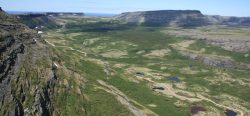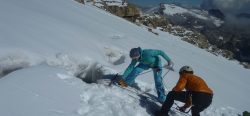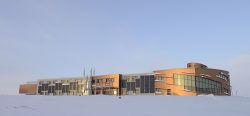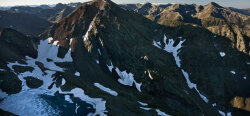STATION NAME AND OWNER
The DMI Geophysical Observatory Qaanaaq. Owned by the Danish Meteorological Institute, Copenhagen, Denmark
LOCATION
The DMI Geophysical Observatory Qaanaaq is located at the outer perimeter of the city of Qaanaaq in North West Greenland. The station connects different monitoring infrastructures in the region. Qaanaaq is a modern Greenlandic city.
Qaanaaq is located outside the main National Park and the nature reserve area in the Melville Bay. Still, in particular marine activities are regulated in order not to disturb the Narwhal during summer.
The city of Qaanaaq is located on a small peninsula at the northern flank of the deep Inglefield Fjord. A number of glaciers terminate into the fjord and the prominent North Water Winter Polynya reach to the mouth of the fjord. Qaanaaq connects a number of small settlements in the region.
BIODIVERSITYBiological diversity. The many and varied forms of life on Earth (collectively known as biota). As well as diversity of species (species diversity), there is also diversity within populations of a... More AND NATURAL ENVIRONMENT
Qaanaaq has a cold, dry, tundraA type of ecosystem in which tree growth is limited by low temperatures. The origin of the word is from from the Kildin Sami word t?ndâr, meaning "uplands" or "treeless mountain tract". In the northern... More climateThe average weather we would expect over a long period of time (seasons, years, decades). Climate varies from place-to-place across the Earth. Climate is determined by long-term (over at least... More with running water only during four months a year. The peninsula is covered by a small local ice cap, the Qaanaaq ice cap. The city is based on permafrostPermafrost is frozen ground that remains at or below zero degrees Celsius (32 degrees Fahrenheit) for two or more years. It forms in regions where the mean annual temperature is... More and the fjord is covered by land fast ice from December through June. In summer, Inglefield Fjord is a key habitat for Narwhal and activities in the region includes extensive winter fishing for halibut and hunting of walrus.
HISTORY AND FACILITIES
The DMI Geophysical Observatory Qaanaaq Station was established in the 1950’s and has a local full time manager year round. The main station includes a small workshop but at present no lab facilities. It has an apartment for 2-4 with kitchen and shower. The station meets local standards and stays open year round though some upgrades are planned during the coming years. Internet access and telephone is available and the local manager has a pick-up van.
GENERAL RESEARCH AND DATABASES
In addition to classical meteorological measurements, it has served as a multidisciplinary Geophysical Observatory. Ongoing monitoring today includes infrasound and geomagnetism. In the latter years DMI has developed a participatory ocean and cryospherePlaces on earth where water is in its solid form, frozen into ice or snow. This includes polar regions but also high altitude areas (high mountains). In a region's winter,... More monitoring program with offset in the station in collaboration with local hunters and with focus on the winter season. Monitoring data are presently only available from DMI data bases. Data from research programs is planned to be integrated in open databases (e.g. G-E-M).
HUMAN DIMENSION
Qaanaaq is a modern Greenlandic city; still subsistence hunting and fishing is an important part of the local economy.
ACCESS
Qaanaaq has weekly connecting flights from Ilulissat (AirGreenland), in summer twice a week. Qaanaaq may also be reached by Helicopter from the nearby US airbase in Thule though this will require special permits. In summer, the city is resupplied by ship from Nuuk (Royal ArcticDefinitions of the Arctic vary according to environmental, geographical, political, cultural and scientific perspectives. Some scientists define the Arctic as areas having a high latitude, long winters, short, cool summers,... More Line). There is no public transport, not taxies in the city. Pickup from the airport can be arranged with the station manager. Local transport is mainly by small boats in summer and dog sleds during winter.






















